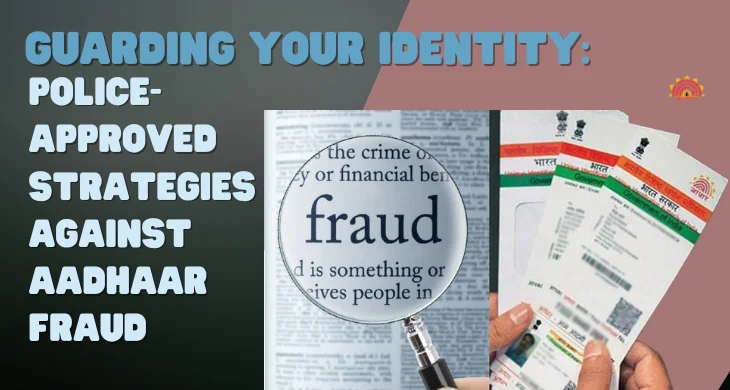In the digital age, guarding your identity is of consummate significance. Your Aadhaar card, a critical identity document in India, is also susceptible to fraud and abuse. To combat this trouble, it’s pivotal to be apprehensive of police- approved strategies that can help guard your identity against Aadhaar fraud. In this comprehensive blog, we will explore the pitfalls associated with Aadhaar fraud, understand the tactics used by fraudsters, and claw into effective strategies championed by law enforcement agencies to cover your identity.
The Significance of Aadhaar in India:
Aadhaar, the 12- number unique identification number issued by the Indian government, serves as a crucial identity document for residers. It’s linked to multitudinous services, including fiscal deals, mobile connections, government subventions, and more. This wide use makes Aadhaar a high target for fraudsters. Aadhaar’s significance in India goes beyond being a bare identification number; it’s a transformative tool that has streamlined government services, bettered fiscal addition, reduced fraud, and empowered citizens. Its part in India’s trip towards a further inclusive, digital, and effective society can not be exaggerated.
Common Tactics Employed by Fraudsters in Aadhaar Fraud:
Fraudsters employ various tactics and techniques in Aadhaar fraud attempts. Being aware of these common tactics can help individuals recognize potential threats and protect themselves from falling victim to fraud. Here are some of the tactics employed by fraudsters:
- Phishing: Fraudsters send deceptive emails, messages, or make phone calls posing as legitimate authorities, such as government officials or Aadhaar representatives. They request individuals to provide their Aadhaar details, including the Aadhaar number, OTPs (One-Time Passwords), or other sensitive information.
- Biometric Spoofing: Some advanced fraudsters may attempt biometric spoofing, where they use manipulated biometric data to gain unauthorized access to Aadhaar-authenticated services or transactions.
- Impersonation during Enrollment: During the Aadhaar enrollment process, fraudsters may impersonate individuals or provide fraudulent documents to obtain multiple Aadhaar cards. This can result in duplicate identities and misuse of Aadhaar.
- Identity Theft: Identity theft involves the fraudulent use of someone else’s Aadhaar details to commit various illegal activities, including financial fraud, obtaining loans, opening bank accounts, or acquiring SIM cards.
- Unlawful Mobile Number Change: Fraudsters may unlawfully change the registered mobile number linked to an individual’s Aadhaar card. This can allow them to take control of Aadhaar-related transactions and activities.
- Misuse of Aadhaar for Subsidies and Benefits: Some fraudsters misuse someone else’s Aadhaar to claim government subsidies, benefits, or entitlements meant for the legitimate Aadhaar holder, diverting these resources for their gain.
Police-Approved Strategies to Prevent Aadhaar Fraud:
Law enforcement agencies endorse specific strategies to prevent Aadhaar fraud and protect individuals from identity theft and fraudulent activities. These strategies are designed to enhance security and reduce the risk of falling victim to Aadhaar-related scams. Here are police-approved strategies to prevent Aadhaar fraud:
- Verify All Requests: Always verify the authenticity of any communication or request related to Aadhaar. Be cautious of unsolicited emails, phone calls, or messages requesting your Aadhaar details. Legitimate authorities will not ask for this information through unsolicited communication.
- Protect Your Aadhaar Number: Safeguard your Aadhaar number as you would with any sensitive personal information. Do not share it with anyone unless you trust the source and have verified their identity.
- Use Official Channels: When updating or accessing Aadhaar-related services, use official channels provided by the Unique Identification Authority of India (UIDAI) or authorized agencies. Avoid third-party or unofficial websites or apps for Aadhaar services.
- Aadhaar Lock/Unlock: Take advantage of the Aadhaar Lock/Unlock feature provided by UIDAI. This feature allows you to lock and unlock your Aadhaar biometrics, adding an extra layer of security.
- Regularly Monitor Aadhaar Activity: Check your Aadhaar authentication history on the official UIDAI website to monitor any unauthorized or suspicious activity. If you notice any discrepancies, report them immediately.
- Secure Your Registered Mobile Number: Ensure that your registered mobile number linked to Aadhaar is up-to-date and secure. Fraudsters often attempt Aadhaar-related fraud via unauthorized mobile number changes. Be vigilant about any changes to your registered mobile number.
- Beware of Phishing Scams: Be cautious of phishing scams that impersonate government authorities or Aadhaar-related entities. Verify the source and legitimacy of any requests for Aadhaar information.
- Report Suspicious Activity: If you suspect any unauthorized use of your Aadhaar or identity, report it immediately to relevant authorities, such as the police or UIDAI.
- Stay Informed: Stay informed about Aadhaar-related scams and fraud prevention measures through official sources. Awareness is a crucial defense against fraud.
- Educate Others: Share these strategies and awareness about Aadhaar fraud prevention with family, friends, and acquaintances. Preventing fraud is a collective effort.
By following these police-approved strategies, individuals can significantly reduce the risk of falling victim to Aadhaar fraud. Prevention is key to maintaining the security and integrity of Aadhaar-related information and services.
Frequently Asked Questions:
Ques: What is Aadhaar fraud?
Ans: Aadhaar fraud involves unauthorized access or misuse of Aadhaar details for fraudulent activities, including identity theft, financial fraud, and impersonation.
Ques: Why is Aadhaar fraud a concern?
Ans: Aadhaar is linked to various services and benefits. Fraud can lead to financial loss, identity theft, and misuse of personal information.
Ques: What are the common tactics used by Aadhaar fraudsters?
Ans: Common tactics include phishing, biometric spoofing, impersonation during enrollment, identity theft, and unauthorized mobile number changes.
Ques: How can I prevent Aadhaar fraud?
Ans: Police-approved strategies include verifying requests, protecting your Aadhaar number, using official channels, locking/unlocking biometrics, monitoring Aadhaar activity, securing your mobile number, and reporting suspicious activity.
Ques: Is it safe to share my Aadhaar details online?
Ans: It’s advisable to exercise caution and only share Aadhaar details through official, trusted channels. Avoid sharing sensitive information with unknown sources.
Ques: What is the Aadhaar Lock/Unlock feature, and how does it help prevent fraud?
Ans: The Aadhaar Lock/Unlock feature allows you to secure your biometric data. Locking your biometrics prevents unauthorized biometric authentication.
Conclusion
Guarding your identity is a participated responsibility. By staying informed about the pitfalls associated with Aadhaar fraud and enforcing police- approved strategies, you can significantly reduce the chances of falling victim to identity theft or fraud. Flash back, securing your Aadhaar is essential to cover your particular information and maintain the integrity of your identity in the digital world. Stay vigilant and proactive in guarding your identity against Aadhaar fraud.

